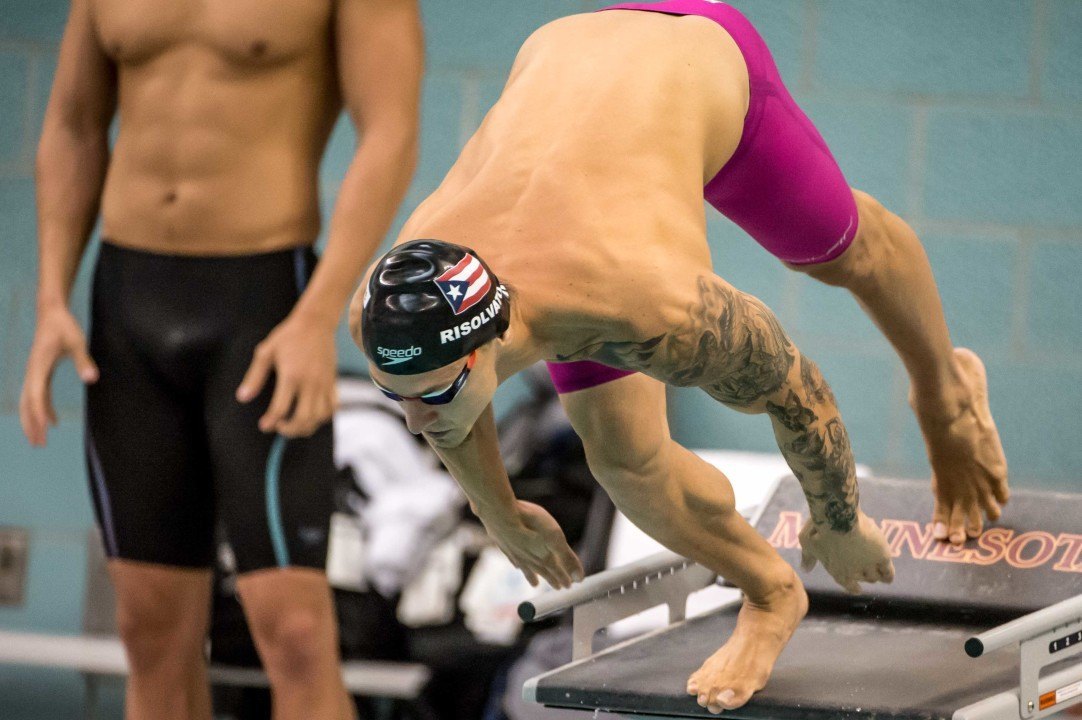Courtesy of Gary Hall Sr., 10-time World Record Holder, 3-time Olympian, 1976 Olympic Games US Flagbearer and The Race Club co-founder.
There are two options for the track start using the back footplate, weight forward or weight backward (slingshot). Before the introduction of the footplate, on the elite men’s side, there was an equal mix of both techniques being used, with neither having a clear advantage over the other. On the elite women’s side, most women used the weight forward technique.
Once the back footplate was introduced, the dynamics of the start changed and today, most elite swimmers prefer the slingshot technique, shifting their weight to the more favorable angle of the back plate. But not all do.
The advantages of the slingshot start are that one can more effectively use the arms, shoulders and both legs to create the propulsive forces, first the back leg, then the front. With the weight forward start, while virtually all of the propulsive force comes from the front leg, this technique generally allows the swimmer to get off the block faster.
With either technique, when the command to take your mark is given, the fingers must grip the front of the block or the bars that run parallel on the top of the block tightly while the arms pull upward. It does not seem to matter too much if the arms are straight or bent slightly for this motion, so long as there is tension on the arms. At The Race Club, we believe that given the option of the bars on top of the block, it is better to grab a hold of them as far forward as possible, rather than grabbing the front of the block. That allows the bend of the knee and waist to be slightly less, creating a mechanical advantage.
If using the slingshot technique, while pulling upward with the arms, you want to feel the weight of the body shift from the front foot to the back foot, being careful not to lean back too much. If you are leaning backward too far, it simply takes too long to get off the block. Moving the body just five or ten degrees backward will cause the shift in weight to occur. Once you feel the majority of the weight on the back foot, stop the motion backward and wait for the beep. The back foot should not be flat, but the heal slightly off the plate. The head should be kept in the neutral or slightly forward-extended position. If using the weight forward technique, the body weight will remain on the front foot, while pulling upward with the arms.
To be in the best possible readiness for the start, there is a right amount of tension one needs to place on the arms and legs. If one is too tense, putting too much pressure on either arms or legs, there is a good chance of flinching, resulting in a disqualification. Too relaxed and one cannot react fast enough or with the required force to get a great start. On a scale of one to ten, where one is completely relaxed and ten is like a twig ready to snap, the right amount of tension will be around a seven. That amount of tension seems to enable a swimmer to create enough force without losing control.
A lot of attention is being given to so-called reaction times, posted for each swimmer on the scoreboard after the start. These times represent the time lapse between the sound of the beep and the front toes leaving the block, which is not really the reaction time. Since the weight-forward starters do not have as far to go to get off of the block, they will nearly always post faster start times. What really matters, however, is where the swimmer breaks out in comparison to all the other swimmers in the race, not how fast they left the block. Most of the elite weight-forward starters that I have seen stay under water for seven to eight fast dolphin kicks, so the speed of the dolphin kick can also influence the technique one chooses.
With either technique you prefer, by following these instructions, you will now be cocked and ready for the starter’s beep. Get ready for our Swimisodes Slingshot Start to launch next week.
Watch the first video in our start series: Swimisodes -Swimming Starts – How to Position Your Feet https://theraceclub.com/videos/swimisodes-swimming-starts-position-feet/
Yours in swimming,
Gary Sr.
Like The Race Club on Facebook
Follow The Race Club on Instagram
Follow The Race Club on Twitter
Connect to The Race Club / Gary Hall Sr. on Linkedin
THE RACE CLUB
Because Life is Worth Swimming, our mission is to promote swimming through sport, lifelong enjoyment, and good health benefits. Our objective is for each member of and each participant in The Race Club to improve his or her swimming performances, health, and self-esteem through our educational programs, services and creativity. We strive to help each member of The Race Club overcome challenges and reach his or her individual life goals.
 The Race Club provides facilities, coaching, training, technical instruction, video, fitness and health programs for swimmers of all ages and abilities. Race Club swim camps are designed and tailored to satisfy each swimmer’s needs, whether one is trying to reach the Olympic Games or simply improve one’s fitness. Our programs are suitable for beginner swimmers, pleasure swimmers, fitness swimmers, USA swimming or YMCA swimmers, or triathletes; anyone who wants to improve swimming skills. All of our Race Club members share an enjoyment of being in the water and use swimming to stimulate a more active mind and body.
The Race Club provides facilities, coaching, training, technical instruction, video, fitness and health programs for swimmers of all ages and abilities. Race Club swim camps are designed and tailored to satisfy each swimmer’s needs, whether one is trying to reach the Olympic Games or simply improve one’s fitness. Our programs are suitable for beginner swimmers, pleasure swimmers, fitness swimmers, USA swimming or YMCA swimmers, or triathletes; anyone who wants to improve swimming skills. All of our Race Club members share an enjoyment of being in the water and use swimming to stimulate a more active mind and body.



Thank you all for your comments. I haven’t seen a flat starting block in a long time, but am sure they still exist. If so, two feet forward might be a better option. One of the best starters of all time, Mark Foster, from UK, insisted on staying with the two feet forward, even with the slanted block…but there are very few that would match the track starters of today with that technique. Most of those that use the weight forward track technique, which gets one in the water the fastest, have exceptional under water kicks and use them to the full 15 meters. Even those that use weight forward with the back foot plate get a little bit of… Read more »
my daughters coach is insisting the kids (11-13) start with their feet together, says for their flat blocks its the best way. She finds it very awkward and prefers a sprint start. what do you guys think?
If the block is truly flat and not pitched the normal 10 degrees, then I would err on the side of feet-together. (What was once called a “grab-start” to distinguish it from a track start). Feet wide and a grab in the middle is easier to balance for some younger kids. As with anything the coach *should* evaluate techniques individually for each kid, but it’s often most expedient to pick something everyone will have success with and a wide-stance grab start is a good place to start for kids who tend to wobble side-to-side in a track start.
Thank you for posting this. I do have a question: If using the front weighted starts, would the footplate make much differences?
Front weighted starts have minimal (balancing only usually) weight on the back foot, so other than using the back plate as a way to ensure one doesn’t slide back off the block, I would say it makes little difference at all.
However, you can still used a modified sling shot start without that back plate. Just need to remember to kick the rear leg up slightly.
Thank you, thank you, thank you.
“What really matters, however, is where the swimmer breaks out in comparison to all the other swimmers in the race, not how fast they left the block.”
This is ever so able to be documented via video, seeing swimmers using a start on blocks with back foot plates, coming out of the water ahead of others not using it, and 2-3 strokes later.
The race is not won by being the first off the block. And being first off the block in no manner assures that the velocity of entry is sufficient to maintain momentum through the underwater phase and break out. For this statement above, alone, many coaches who have been struggling to… Read more »